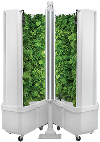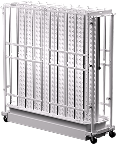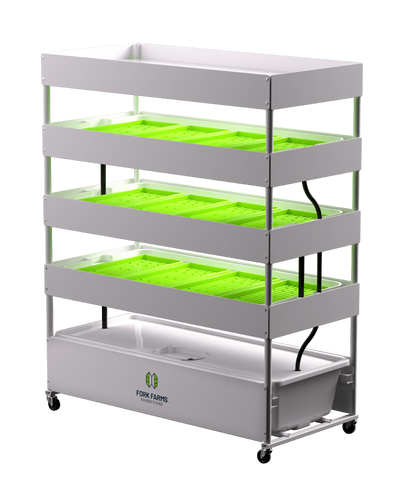What is the Best Time of Year to Plan and Start a School Garden?
When developing a plan and timeline for starting a school garden project, the first question to ask yourself is what kind of garden you are working towards – a traditional outdoor garden or a hydroponic garden? Both types of gardens require planning and organization, but both have different things you’ll need to consider before you get started.
Starting a traditional outdoor garden at a school requires consideration of the local climate, what you want to grow and the school calendar.
If you are creating an outdoor garden, here are some timelines to consideration:
- Fall and winter are the ideal times to plan the garden, work on the space and layout, gather your materials, build your grow team, and choose what to grow in the next calendar year with the students.
- Early spring is the time to prepare the soil and then plant crops like lettuce, spinach and peas.
- In late spring, it is best to plant foods such as tomatoes, peppers, beans, and squash.
- Summer is the growing season when regular maintenance like weeding, watering and general tending to the garden is mandatory. This can be a tricky time of year to grow at a school unless the school has a summer school program or a summer garden program set up, so be sure to have a plan for upkeep during the summer months.
- In mid-to-late August, crops that were planted in late spring/early summer will likely be ready for harvest, so students will need to be ready to get busy in the garden at the start of the school year.
- And, finally, in early September after the garden has been harvested, the students can kick off the new school year by planting vegetables like broccoli, carrots and kale in the school garden. It’s time to grow!
Hydroponic gardens are a different story, offering both pros and cons for schools. Since hydroponic gardens can grow all year long regardless of climate and calendars, they offer more flexibility to both teachers and students. As long as a solid plan for maintaining the hydroponic garden is in place, you can start your school’s hydroponic garden at any time of the year. The most important thing is to start a hydroponic garden at your school whenever you and your team have an interest in doing so.
As in most things, interest and passion are the key ingredients. At Fork Farms, we like to say that starting a hydroponic garden is as simple as building a small team with a high interest in hydroponics, and then adding water. Still, with the flexibility a hydroponic farm offers, some timing factors are important to keep in mind.
- If you’d like your hydroponic garden to align with the natural growing season so students can easily understand plant growth cycles and plant biology, early spring would be the ideal time to set up your hydroponic system. This would allow for a couple of months of growing, learning, and maintaining before the school year comes to an end.
- If the goal is to allow the students access to every step of the process from start to finish, it is best to get the students started on hydroponic growing soon after the school year begins (mid-August to early September). This allows a full nine months of learning and growing opportunities for everyone involved.
Hydroponics offers hundreds of learning opportunities for students in the areas of STEM, nutrition, agriculture, sustainability, and health. By combining hands-on experimentation in real-world farming scenarios, interdisciplinary learning, and technology, hydroponics provides numerous benefits for students' engagement, critical thinking, and problem-solving skills.
Regardless of which timeline you choose, aligning the start of your hydroponic garden with your school’s calendar, curriculum, or the natural growing patterns of plants can enhance learning experiences for students. But to reiterate, whenever there is high interest in starting a new project, take advantage of it. Let’s grow!
Coordinating your Hydroponic Garden with a Plant’s Natural Growing Season:
Winter:
It can take several weeks to plan and set up a hydroponic system, so some schools like to tackle the planning process in the winter when it may be a less busy time of the school year. The winter months can be used to designate a space for the system and to order all the necessary supplies and equipment so you’ll be ready to start growing when spring arrives. By planning in winter and setting up your hydroponic system in early spring, you can take advantage of the natural growing season and capitalize on learning opportunities like plant growth cycles and plant biology.
Spring:
As the weather warms up, this is the perfect time to set up and install your hydroponic system. Even though your system will be indoors and in a controlled environment, starting in early spring aligns well with the natural growing season. This will also be the time to start germinating seeds indoors. This way, by the time the system is fully set up, seedlings will be ready to be transplanted. Choose your plants wisely. Plants like leafy greens and herbs are typically easy to grow and produce high yields quickly, so they are good options when you are first starting your journey with hydroponics.
Summer:
This is the time to watch your plants grow in their system (again, aligning well with natural gardening cycles). Seedlings will need to be planted in the hydroponic system and the grow team will need to maintain the hydroponic farm throughout the summer. Maintaining includes weekly duties such as: checking nutrient concentrations, light intensity, temperature, and pH levels. Depending on what has been growing, planting, transplanting, harvesting, and cleaning may be necessary during the summer months, if you plan to run it. Our Flex Farms produce more than 25 pounds of leafy greens in 28 days, so food grows quickly and efficiently in hydroponic farms.
The flexibility of hydroponic farming with the Flex Farm also allows classrooms to shut down and clean the farm for the summer, and have it ready to go again for the fall semester. The system will grow when it’s convenient for you.
Fall:
Plants will be ready for harvest as students return to school if maintained through the summer, providing wonderful opportunities for hands-on learning and allowing students to see the fruits of their labor first-hand.
Starting a Hydroponic Garden at the Beginning of the School Year Calendar:
Starting a hydroponic gardening project at the beginning of a school year can bring a great deal of excitement to the beginning of the school year and offer students the chance to witness hydroponic growth from start to finish.
This timeline can also aid in maximizing student involvement as this allows for a full nine months of integrating hydroponics into the curriculum. For example, starting a garden in the fall can tie into biology, agriculture, or environmental science courses. At Fork Farms, we offer a complete NGSS K-12 curriculum and tips on how to enhance student engagement by growing fresh food. Every month of the school calendar can bring new opportunities to learn and grow.
Tasks Your Class can Manage While the Flex Farm Grows:
You and your class or “Grow Team” will need to regularly maintain the growing system and the plants, checking nutrient and pH levels, temperature and humidity, and pruning the plants.
Approximately one month after transplanting the seedlings into the Flex Farm, the students will be able to harvest, taste, touch, and share the fresh foods they have grown. After the harvest, the system can be cleaned out and re-planted for more growth and learning. Students can assess what went well in their system and what they may want to change for their next harvest. We often find that students are interested in planting new foods for their second or third harvests like grape tomatoes and peppers to try new flavors and see the differences in growing patterns.
In summary, starting a hydroponic garden can be done at any time of year regardless of factors like season, climate, healthy soil, and available space. If you have questions re: what is the best system for your school or how to start a hydroponic garden at your school, please give Fork Farms a call and we can grow together.
Important Links:
























